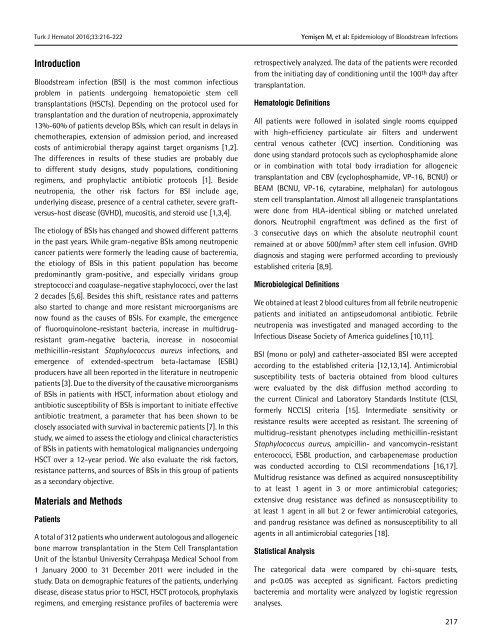Turkish Journal of Hematology Volume: 33 - Issue: 3
Create successful ePaper yourself
Turn your PDF publications into a flip-book with our unique Google optimized e-Paper software.
Turk J Hematol 2016;<strong>33</strong>:216-222<br />
Yemişen M, et al: Epidemiology <strong>of</strong> Bloodstream Infections<br />
Introduction<br />
Bloodstream infection (BSI) is the most common infectious<br />
problem in patients undergoing hematopoietic stem cell<br />
transplantations (HSCTs). Depending on the protocol used for<br />
transplantation and the duration <strong>of</strong> neutropenia, approximately<br />
13%-60% <strong>of</strong> patients develop BSIs, which can result in delays in<br />
chemotherapies, extension <strong>of</strong> admission period, and increased<br />
costs <strong>of</strong> antimicrobial therapy against target organisms [1,2].<br />
The differences in results <strong>of</strong> these studies are probably due<br />
to different study designs, study populations, conditioning<br />
regimens, and prophylactic antibiotic protocols [1]. Beside<br />
neutropenia, the other risk factors for BSI include age,<br />
underlying disease, presence <strong>of</strong> a central catheter, severe graftversus-host<br />
disease (GVHD), mucositis, and steroid use [1,3,4].<br />
The etiology <strong>of</strong> BSIs has changed and showed different patterns<br />
in the past years. While gram-negative BSIs among neutropenic<br />
cancer patients were formerly the leading cause <strong>of</strong> bacteremia,<br />
the etiology <strong>of</strong> BSIs in this patient population has become<br />
predominantly gram-positive, and especially viridans group<br />
streptococci and coagulase-negative staphylococci, over the last<br />
2 decades [5,6]. Besides this shift, resistance rates and patterns<br />
also started to change and more resistant microorganisms are<br />
now found as the causes <strong>of</strong> BSIs. For example, the emergence<br />
<strong>of</strong> fluoroquinolone-resistant bacteria, increase in multidrugresistant<br />
gram-negative bacteria, increase in nosocomial<br />
methicillin-resistant Staphylococcus aureus infections, and<br />
emergence <strong>of</strong> extended-spectrum beta-lactamase (ESBL)<br />
producers have all been reported in the literature in neutropenic<br />
patients [3]. Due to the diversity <strong>of</strong> the causative microorganisms<br />
<strong>of</strong> BSIs in patients with HSCT, information about etiology and<br />
antibiotic susceptibility <strong>of</strong> BSIs is important to initiate effective<br />
antibiotic treatment, a parameter that has been shown to be<br />
closely associated with survival in bacteremic patients [7]. In this<br />
study, we aimed to assess the etiology and clinical characteristics<br />
<strong>of</strong> BSIs in patients with hematological malignancies undergoing<br />
HSCT over a 12-year period. We also evaluate the risk factors,<br />
resistance patterns, and sources <strong>of</strong> BSIs in this group <strong>of</strong> patients<br />
as a secondary objective.<br />
Materials and Methods<br />
Patients<br />
A total <strong>of</strong> 312 patients who underwent autologous and allogeneic<br />
bone marrow transplantation in the Stem Cell Transplantation<br />
Unit <strong>of</strong> the İstanbul University Cerrahpaşa Medical School from<br />
1 January 2000 to 31 December 2011 were included in the<br />
study. Data on demographic features <strong>of</strong> the patients, underlying<br />
disease, disease status prior to HSCT, HSCT protocols, prophylaxis<br />
regimens, and emerging resistance pr<strong>of</strong>iles <strong>of</strong> bacteremia were<br />
retrospectively analyzed. The data <strong>of</strong> the patients were recorded<br />
from the initiating day <strong>of</strong> conditioning until the 100th day after<br />
transplantation.<br />
Hematologic Definitions<br />
All patients were followed in isolated single rooms equipped<br />
with high-efficiency particulate air filters and underwent<br />
central venous catheter (CVC) insertion. Conditioning was<br />
done using standard protocols such as cyclophosphamide alone<br />
or in combination with total body irradiation for allogeneic<br />
transplantation and CBV (cyclophosphamide, VP-16, BCNU) or<br />
BEAM (BCNU, VP-16, cytarabine, melphalan) for autologous<br />
stem cell transplantation. Almost all allogeneic transplantations<br />
were done from HLA-identical sibling or matched unrelated<br />
donors. Neutrophil engraftment was defined as the first <strong>of</strong><br />
3 consecutive days on which the absolute neutrophil count<br />
remained at or above 500/mm 3 after stem cell infusion. GVHD<br />
diagnosis and staging were performed according to previously<br />
established criteria [8,9].<br />
Microbiological Definitions<br />
We obtained at least 2 blood cultures from all febrile neutropenic<br />
patients and initiated an antipseudomonal antibiotic. Febrile<br />
neutropenia was investigated and managed according to the<br />
Infectious Disease Society <strong>of</strong> America guidelines [10,11].<br />
BSI (mono or poly) and catheter-associated BSI were accepted<br />
according to the established criteria [12,13,14]. Antimicrobial<br />
susceptibility tests <strong>of</strong> bacteria obtained from blood cultures<br />
were evaluated by the disk diffusion method according to<br />
the current Clinical and Laboratory Standards Institute (CLSI,<br />
formerly NCCLS) criteria [15]. Intermediate sensitivity or<br />
resistance results were accepted as resistant. The screening <strong>of</strong><br />
multidrug-resistant phenotypes including methicillin-resistant<br />
Staphylococcus aureus, ampicillin- and vancomycin-resistant<br />
enterococci, ESBL production, and carbapenemase production<br />
was conducted according to CLSI recommendations [16,17].<br />
Multidrug resistance was defined as acquired nonsusceptibility<br />
to at least 1 agent in 3 or more antimicrobial categories;<br />
extensive drug resistance was defined as nonsusceptibility to<br />
at least 1 agent in all but 2 or fewer antimicrobial categories,<br />
and pandrug resistance was defined as nonsusceptibility to all<br />
agents in all antimicrobial categories [18].<br />
Statistical Analysis<br />
The categorical data were compared by chi-square tests,<br />
and p

















